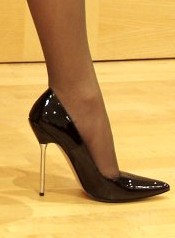High heels

|
High-heeled footwear (often abbreviated as high heels) is footwear which raise the heel of the wearer's foot significantly higher than the toes. When both the heel and the toes are raised equal amounts, as in a platform shoe, it is not considered to be a "high-heel". This tends to give the illusion of longer and more slender legs. High heels come in a wide variety of styles, and the heels are found in many different shapes, including stiletto, pump, block, tapered, blade and wedge.
According to high fashion shoe websites like Jimmy Choo and Gucci, a "low heel" is considered less than 6 centimeters (2.5 inches), while 6 centimeters to 8.5 centimeters (3.5 inches) heels are considered "mid heels," and anything over 8.5 centimeters is considered a "high heel".
Although high heels are almost exclusively worn by girls and women, there are shoe designs worn by both genders that have elevated heels, including cowboy boots and cuban heels. Transvestites and cross-dressers usually prefer high heels because they are regarded as particularly feminine.
History
Raised heels are stated to have been a response to the problem of the rider's foot slipping forward in stirrups while riding. The "rider's heel," approximately 1-1/2" high, appeared around 1500. The leading edge was canted forward to help grip the stirrup, and the trailing edge was canted forward to prevent the elongated heel from catching on underbrush or rock while backing up, such as in on-foot combat. These features are evident today in riding boots, notably cowboy boots.
The simple riding heel gave way to a more stylized heel over its first three decades. Beginning with the French, heel heights among men crept up, often becoming higher and thinner, until they were no longer useful while riding, but were relegated to "court-only" wear. By the late 1600s men's heels were commonly between three and four inches in height.
In 1533, the diminutive wife of the Duke of Orleans, Catherine de' Medici, commissioned a cobbler to fashion her a pair of heels, both for fashion, and to increase her stature. They were an adaptation of chopines (elevated wooden soles with both heel and toe raised not unlike modern platform shoes), but unlike chopines the heel was higher than the toe and the "platform" was made to bend in the middle with the foot.
High-heeled shoes quickly caught on with the fashion-conscious men and women of the French court, and spread to pockets of nobility in other countries. The term "well-heeled" became synonymous with opulent wealth. Both men and women continued wearing heels as a matter of noble fashion throughout the seventeenth and eighteenth centuries. When the French Revolution drew near, in the late 1700s, the practice of wearing heels fell into decline in France due to its associations with wealth and aristocracy. Throughout most of the 1800s, flat shoes and sandals were usual for both sexes, but the heel resurfaced in fashion during the late 1800s, almost exclusively among women.
High heels today
Throughout the last 60 years, high-heels have fallen in and out of favor several times, most notably in the late 90s, when lower heels and even flats predominated. Lower heels were preferred during the late 60s and early 70s as well, but higher heels returned in the late 80s and early 90s. The shape of the fashionable heel has also changed from block (70s) to tapered (90s), and stiletto (50s, 80s, and post-2000).
Today, high-heels are typically worn by women, with heights varying from a Cuban heel of 1½" to a stiletto heel (or spike heel) of 4" or more. Extremely high-heeled shoes, such as those higher than 5", are normally worn only for aesthetic reasons and are not considered practical. Court shoes are conservative styles and often used for work and formal occasions, while more adventurous styles are common for evening wear and dancing. High-heels have seen significant controversy in the medical field lately, with many podiatrists seeing patients whose severe foot problems have been caused almost exclusively by high-heel wear.
Wedge heel is another style of the heel, where heel is in a wedge form and continues all the way to the toe of the shoe.
- Reasons for wearing high-heels, which are almost exclusively aesthetic, include
- they change the angle of the foot with respect to the lower leg, which accentuates the appearance of calves
- they change the wearer's posture, requiring a more upright carriage and altering the gait in what is considered a seductive fashion
- they make the wearer appear taller
- they make the legs appear longer and the lower leg muscles better defined
- they make the foot appear smaller
- they make the gluteal muscles more defined while wearing leggings or tight trousers; see gluteal fold
Both men and women regard women in high heels as more attractive; researchers "suggest that high heels may exaggerate the sex-specific aspects of the female walk which could cause sexual arousal in males and make women aware of potential competitors for mates." [1]
- Reasons for not wearing high-heels include
- they can cause foot pain
- they can create foot deformities, including hammertoes and bunions
- they can cause an unsteady gait
- they can shorten the wearer's stride
- they can render the wearer unable to run
- altered forces at the knee caused by walking in high-heels may predispose to degenerative changes in the knee joint
Anyone who has seen a lady wearing heels will attest to their bondage roots. No-one wearing heels can do more than walk with well thought out choreography. Again, the ability to run has been removed. Shoes with heels over seven inches are referred to as ‘bedroom shoes’ because the wearer is held captive, unable to stand or run away from their aggressive male counterpart.
See also
| This page uses content from SM-201; the original article can be viewed heels here. |
